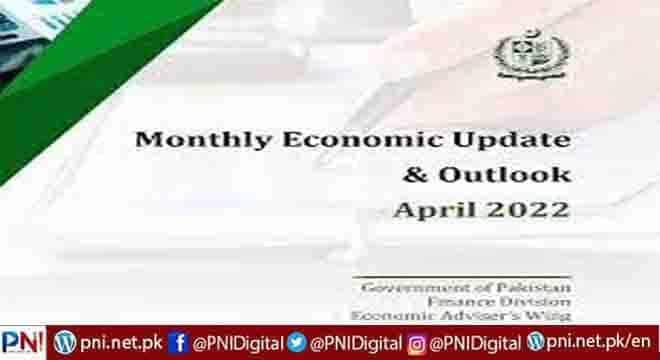ISLAMABAD, Apr 29 (APP):Although the economic recovery is underway, the international developments and persistent high domestic inflation might impact domestic economic activities, says Monthly Economic Update and Outlook, April 2022 released here on Friday.
“The domestic and international scenario is changing over the course of time. Thus, inflationary, and external sectors risks are building macroeconomic imbalances,” notes the report released by Finance Ministry.
Among the determining factors of current trends in both international and domestic inflation are supply chain issues and surging international commodity prices.
It says, under normal circumstances, these prices follow a cyclical pattern; implies that normally, price spikes are followed by a cooling-off period. But, it adds, the current cycles of international food and oil prices were different as the volatility in the markets is high compared to historical standards. Second, due to geo-political tensions, the increasing trend in prices may remain intact.
The high inflation and the accompanying monetary policy reaction may temporarily dampen the cyclical position of Pakistan’s economy thereby reducing growth prospects in the short run.
But in the long-run, Pakistan’s productive capacity will determine the growth as well as employment prospects, it says adding this required a substantial upward shift in the propensity to invest and of the productivity of investment expenditures.
Stimulating the propensity to invest implies that a larger share of the income that the country generates is used to finance Gross Fixed Capital Formation. Structural policies are to be further designed to attract more productive investments from foreign sources (Foreign Direct Investments) and from both private and public domestic investors.
High international commodity prices not only keep inflation elevated, they are also a burden on Pakistan’s external account and hence on its foreign exchange reserves.
Many other countries are facing the consequences of high and volatile commodity prices, especially oil and gas prices, it observes.
Strengthening of Pakistan’s overall supply side through increasing its productive potential would allow it to produce more for exports and to discourage import.
These prospects would relax the external constraint that has historically weighed on Pakistan’s economy and which has caused regular Balance of Payments crises and an accompanying stop-and-go profile in Pakistan’s economic growth path.
While reviewing the performance of April 2022, the report observes that Pakistan’s economy was on growth trajectory confronting risks of inflation and external sectors pressures.
It says, the production of all major Kharif crops increased compared to last year’s production while during July- March FY2022, the agriculture credit disbursement increased by 0.5 percent to Rs 958.3 billion compared to Rs 953.7 billion in same period last year.
During Jul-Feb FY 2022, LSM witnessed the growth of 7.8 percent against the growth of 2.2 percent same period last year.
The Consumer Price Index (CPI) inflation was recorded at 10.8 percent during Jul-Mar compared to 8.3 percent in the same period of last year while CPI for the March 2022 was recorded at 12.7 percent on YoY basis against 9.1 percent in March 2021.
The overall spike in CPI is on account of increased in the prices of imported items, as the country is a net importer of items especially crude oil, pulses and edible oil which ultimately transmitted into domestic prices. Upward price movement is further fueled by Russia Ukraine war, supply chain disruption and recovery in global demand.
During the first nine months of the current fiscal year, the fiscal deficit stood at 4.0 percent of GDP against 3.0 percent of GDP (on the basis of revised GDP) last year. Similarly, the primary balance posted a deficit of Rs 447.2 billion (-0.7 percent of GDP) as compared to surplus of Rs 451.8 billion (0.8 percent of GDP).
The provisional net tax collection during Jul-Mar FY2022 grew by 28.9 percent to stand at Rs 4,375.6 billion against Rs 3393.7 billion in the same period of last year. During the first nine months of the current fiscal year, FBR exceeded its revenue target by 5.8 percent.
In Jul-Mar, FDI reached $ 1,285.1 million ($ 1,311.1 million last year) decreased by 2.0 percent. In March net outflow was recorded at $ 30.4 million, on account of political instability which resulted in change of regime.
In Jul-Mar FY2022, workers’ remittances reached $ 23.0 billion ($ 21.4 billion last year), increased by 7.1 percent. Workers’ remittances continued their unprecedented run of above $ 2.0 billion since June 2020.
Pakistan’s total liquid foreign exchange reserves stood at $ 16.8 billion on April20, 2022, with the SBP’s reserves recorded at $10.6 billion, while commercial banks’ reserves remained at $6.2 billion.
Follow the PNI Facebook page for the latest news and updates.








